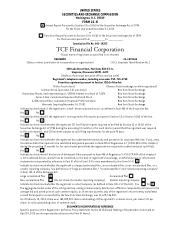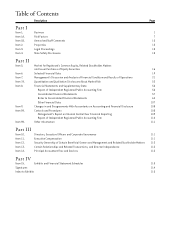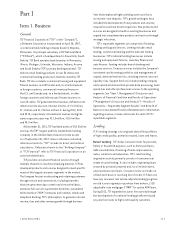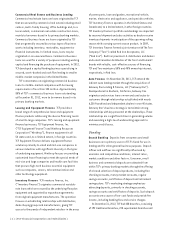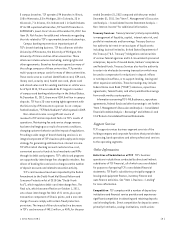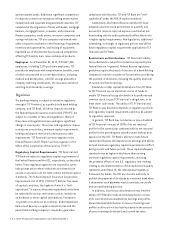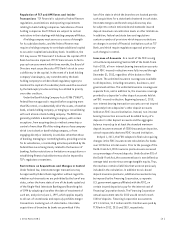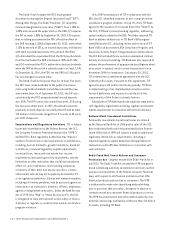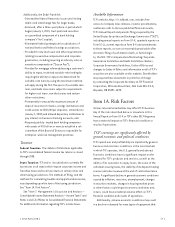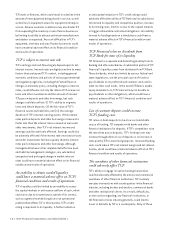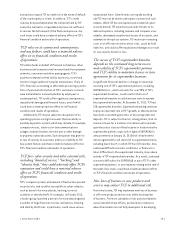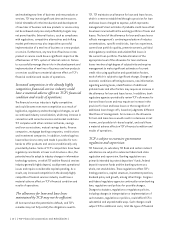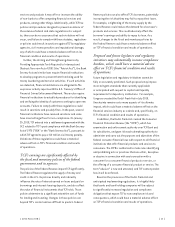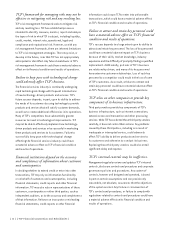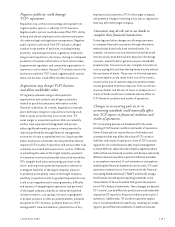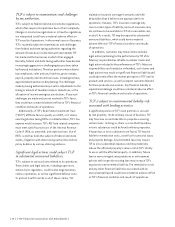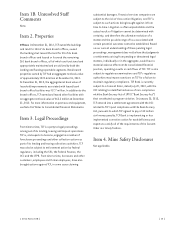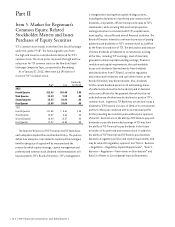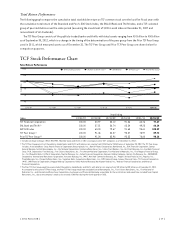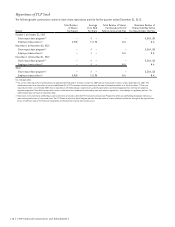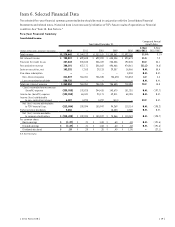TCF Bank 2012 Annual Report Download - page 25
Download and view the complete annual report
Please find page 25 of the 2012 TCF Bank annual report below. You can navigate through the pages in the report by either clicking on the pages listed below, or by using the keyword search tool below to find specific information within the annual report.transactions expose TCF to credit risk in the event of default
of the counterparty or client. In addition, TCF’s credit
risk may be exacerbated when the collateral held by TCF
cannot be realized or is liquidated at prices not sufficient
to recover the full amount of the financial exposure. Any
such losses could have a material adverse effect on TCF’s
financial condition and results of operations.
TCF relies on its systems and counterparties,
and any failures could have a material adverse
effect on its financial condition and results
of operations.
TCF settles funds on behalf of financial institutions, other
businesses and consumers and receives funds from payment
networks, consumers and other paying agents. TCF’s
businesses depend on their ability to process, record and
monitor a large number of complex transactions. If any of
TCF’s financial, accounting or other data processing systems
fail or if personal information of TCF’s customers or clients
were mishandled or misused (whether by employees or
counterparties), TCF could suffer regulatory consequences,
reputational damage and financial losses, any of which
could have a material adverse effect on its financial
condition and results of operations.
Additionally, TCF may be subject to disruptions of its
operating systems arising from events that are wholly or
partially beyond its control, which may include, for example,
computer viruses, electrical or telecommunications
outages, natural disasters, terrorist acts or other damage
to property or physical assets. Such disruptions may give rise
to loss of services to customers and loss or liability to TCF.
Any system failure could have a material adverse effect on
TCF’s financial condition and results of operations.
TCF faces cyber-security and other external risks,
including “denial of service,” “hacking” and
“identity theft,” that could adversely affect TCF’s
reputation and could have a material adverse
effect on TCF’s financial condition and results
of operations.
TCF’s computer systems and network infrastructure present
security risks, and could be susceptible to cyber-attacks,
such as denial of service attacks, hacking, terrorist
activities or identity theft. For example, in October 2012,
a hacker group launched a denial of service attack against
a number of large financial services institutions. Hacking
and identity theft risks, in particular, could cause serious
reputational harm. Cyber threats are rapidly evolving
and TCF may not be able to anticipate or prevent all such
attacks. While TCF has not experienced a material cyber-
security breach, TCF experiences periodic threats to its
data and systems, including malware and computer virus
attacks, attempted unauthorized access of accounts, and
attempts to disrupt our systems. TCF may incur increasing
costs in an effort to minimize these risks, could be held
liable for, and could suffer reputational damage as a result
of, any security breach or loss.
The success of TCF’s supermarket branches
depends on the continued long-term success
and viability of TCF’s supermarket partners
and TCF’s ability to maintain licenses or lease
agreements for its supermarket locations.
A significant financial decline or change in ownership
involving one of TCF’s supermarket partners, including
SUPERVALU,Inc., which accounts for over 95% of TCF’s
supermarket branches, could result in the loss of
supermarket branches or could increase costs to operate
the supermarket branches. At December 31, 2012, TCF had
228 supermarket branches. Supermarket banking continues
to play an important role in TCF’s growth, as these branches
have been consistent generators of account growth and
deposits. TCF is subject to the risk, among others, that its
license or lease for a location or locations will terminate
upon the sale or closure of that location or locations by the
supermarket partner, especially in light of SUPERVALU’s
announcement on January 10, 2013 that it had entered
into an agreement to sell several of its supermarket chains,
including Jewel-Osco®; in which TCF has 157 branches. Also,
continued difficult economic conditions, or financial or
labor difficulties in the supermarket industry, may reduce
activity in TCF’s supermarket branches. As a result, continued
economic difficulties for SUPERVALU or any of TCF’s other
supermarket partners, or uncertainties relating to the sale of
the Jewel-Osco chain, could have a material adverse effect
on TCF’s financial condition and results of operations.
New lines of business or new products and
services may subject TCF to additional risk.
From time to time, TCF may implement new lines of business
or offer new products and services within existing lines
of business. There are substantial risks and uncertainties
associated with these efforts, particularly in instances
where the markets are not fully developed. In developing
{ 2012 Form 10K } { 9 }


